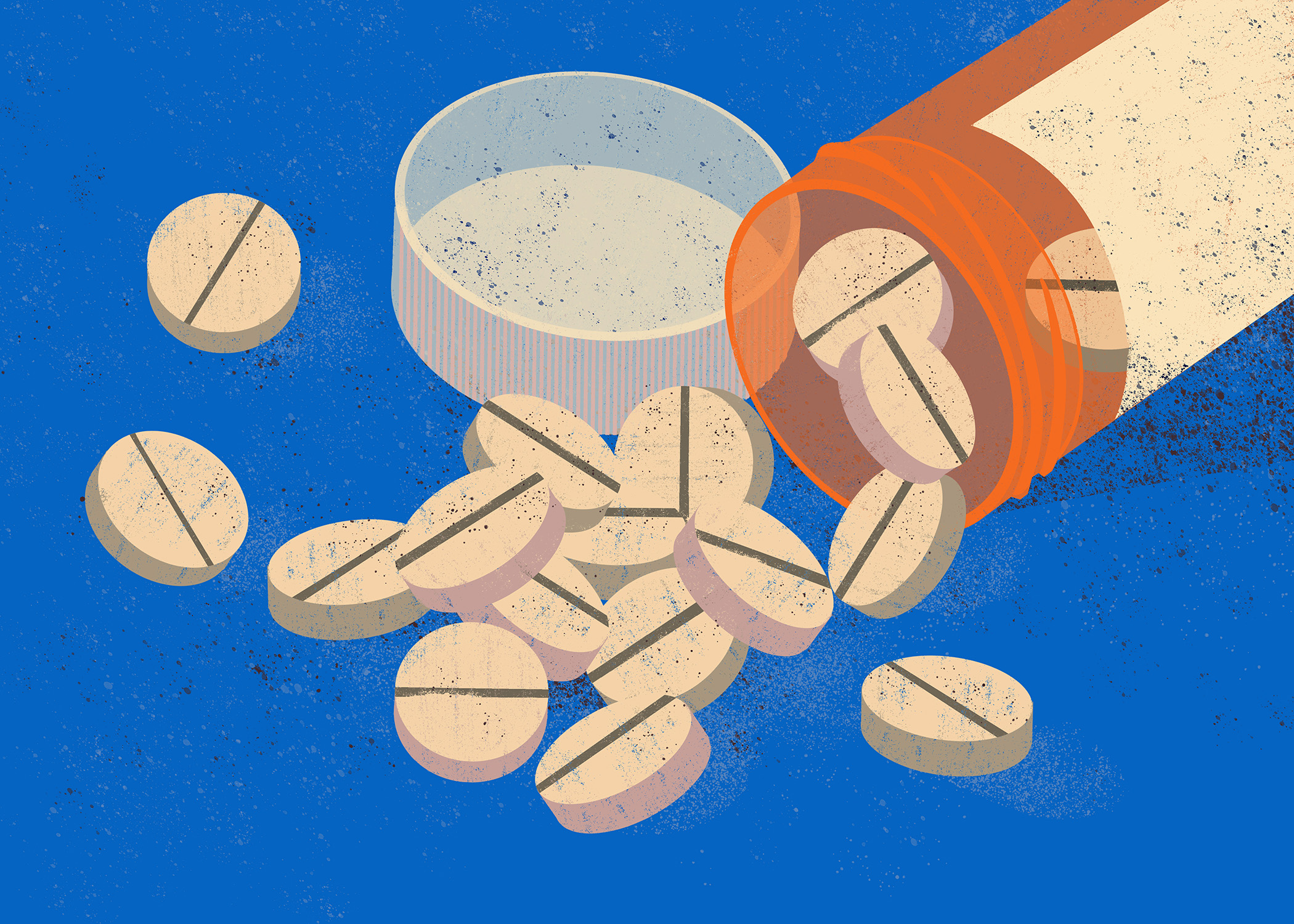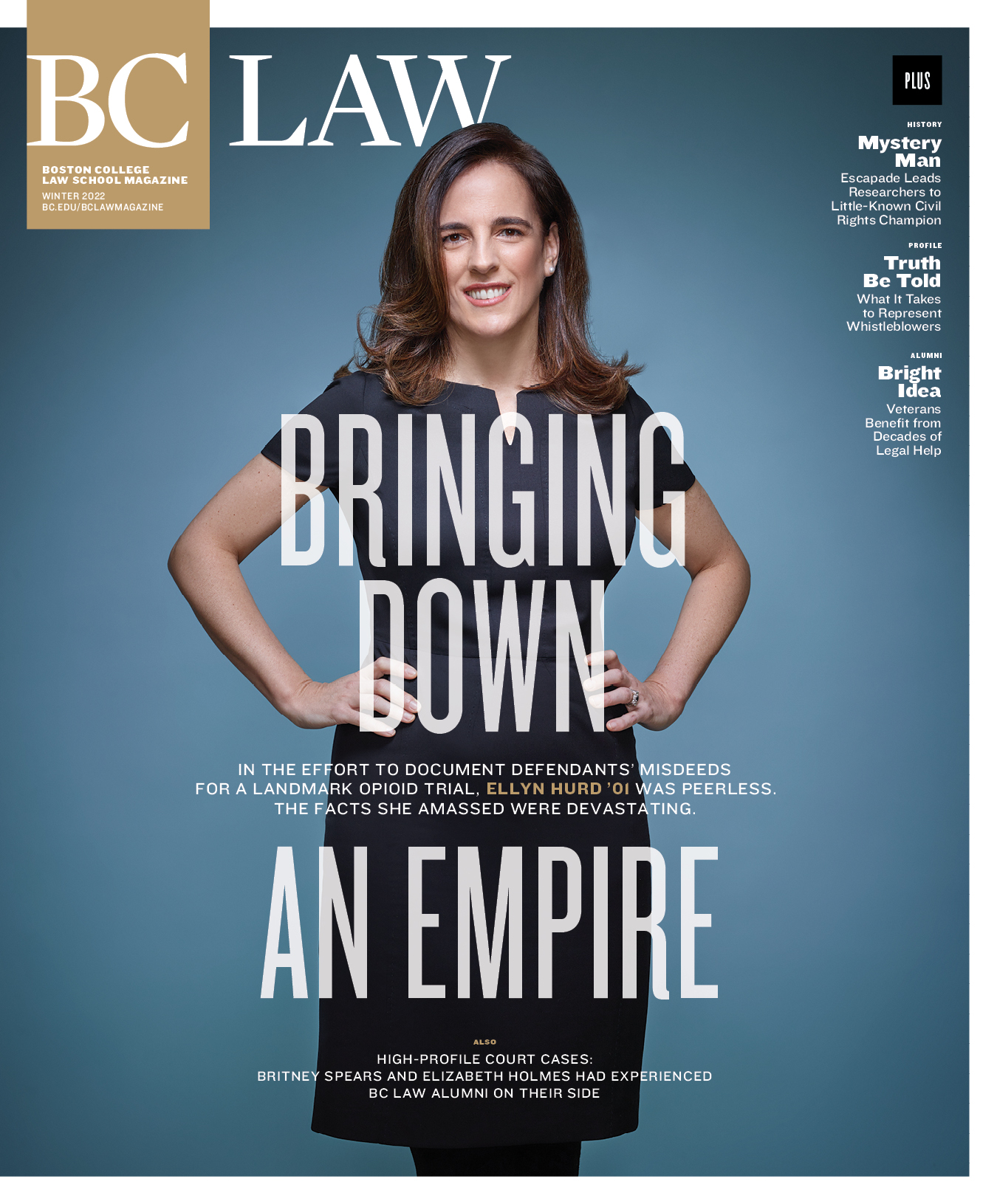In the waning hours of 2021, a potentially game-changing shift occurred in the legal landscape of civil suits arising from the nation’s decades-long opioid epidemic. A six-member jury in New York found opioid manufacturer Teva Pharmaceuticals USA, Inc. and its affiliates liable for wrongdoing. That alone was a head-turner, given recent setbacks for plaintiffs elsewhere in the country. But add in the facts that the case involved two dozen defendants and targeted operators throughout the entire opioid supply chain, and that the legal teams on both sides were so large that the court actually moved to an auditorium to accommodate everyone—only then does the scale of the proceedings begin to come clear.
In matters of proportion, perhaps no one on the ten-member Suffolk County prosecution team from Simmons Hanly Conroy, LLC played a bigger role than Ellyn Heimlich Hurd, a 2001 graduate of Boston College Law School.
Suffolk County argued the case alongside New York State and Nassau County. As de facto second chair in Simmons Hanly’s stable, Hurd’s job was to catalog, make intelligible, and essentially debone a slab of evidence so ponderous that the sheer tonnage could overwhelm a jury with confusion and uncertainty.
“The fact that it’s so huge and involves so many documents and, initially, so many defendants, it’s like working on a lot of cases within this big case,” says Hurd. “[The opioid] case has had everything that I can imagine. Allegations of discovery violations, perjury accusations, bankruptcy, Covid. It seemed like we faced a new challenge every day.”
In the course of the six-month trial, more than seventy witnesses testified and jurors reviewed in excess of 800 written records. Presiding New York State Supreme Court Justice Jerry Garguilo likened the lawsuit, along with the nation’s throng of similar opioid cases, to the 1950s sci-fi Hollywood horror phenomenon, The Blob.
Many have seen the opioid phenomenon as similar to that of the tobacco industry in the 20th century, albeit one that has played out more swiftly. After many years of deceptive practices and deaths—one estimate puts the last century’s worldwide tobacco death toll at 100 million—things came to a head for tobacco in the mid-1990s. Forty-six states united to sue tobacco companies for the hospital bills of millions of American smokers. The resulting Tobacco Master Settlement Agreement in 1998 forever changed cigarettes and won a $365 billion legal victory. If that outcome was Big Tobacco’s Stalingrad, as VICE Magazine put it, The County Of Suffolk v. Teva Pharmaceuticals USA has a chance to be the same kind of reckoning for Big Pharma.
One notable distinction? Here, it is not just the states suing. It is the individual counties, cities, and towns across the nation that have, over the last decade, been bearing the financial brunt of trying to combat the ongoing epidemic on their own with community programs and other services.

“Preparing day after day for direct and cross examinations that avoid, to the ex-tent possible, evidentiary pitfalls, is grueling but satisfying. I love what I do, knowing that my contribution is valued. It’s also gratifying to know that we are fighting the good fight.”
Ellyn Hurd ’01
OPIOIDS ARE A BROAD CLASS of powerful pain-relieving drugs, both naturally occurring and synthetic, that are addictive whether or not they are taken as directed or under a doctor’s care. Dispensed primarily to end-of-life cancer patients in decades past, opioids swiftly became the go-to drug for a host of pain ailments when providers and drug companies began catering to demand, much of it allegedly of their own making. Indeed, documents that came to light during the Suffolk trial show, among other things, that defendants trained their sales representatives that people do not become addicted if in pain. That is, and has always been, scientifically false. Nationally, the rate of opioids sold rose sharply in the early 2000s. Abuses soon followed, as did US deaths from prescription opioids. Illegally manufactured drugs and street dealing naturally flowed and exacerbated the problem.
The immediate backdrop to Hurd’s twenty-seven-month involvement in the Suffolk case was like a Homeric allegory. In early 2020, as Hurd helped to prepare for trial against the opioid supply chain, Covid-19 took America’s opioid epidemic from crisis to catastrophe. In the twelve-month period ending in April 2021, some 100,000 Americans died of overdoses, more than double the toll in 2017, when the US Department of Health and Human Services issued an opioid-related public health emergency.
The legal fallout has been roughly 3,000 federal and several hundred state cases across the country. Prominent cases recently in the news have been heard in California and Oklahoma. The New York case is one-of-a-kind in several ways. It is the first opioid case in the nation where a jury, as opposed to a judge, was charged with rendering a verdict in a trial involving different types of companies. It is believed by participants to be the longest jury trial in New York history. It is also distinct because one of the original named defendants was well-known Purdue Pharma, owned by the Sackler family, now embroiled in another tangle of lawsuits.
The Suffolk opioid trial was also one of winnowing and perseverance. By the time the case went to the jury on December 14, the twelve targeted entities, including manufacturers, distributors, and retail pharmacies, had dwindled to one remaining litigant, Teva and its affiliates, makers and merchandisers of branded and generic opioid drugs. At that point, the other defendants were either in bankruptcy or had become parties to a settlement.
The Suffolk County complaint claimed that the original gaggle of defendants ran afoul of public nuisance law by using false and misleading marketing to push the off-label use of addictive pain medications; prioritizing pill distribution and profits over public health by concealing facts from the medical community, patients, and healthcare payors; failing to maintain federally mandated monitoring controls, and more—thereby interfering with the public’s right to health and general welfare.
The legal standard for a public nuisance claim requires that plaintiffs demonstrate clear and convincing evidence that the defendant(s) interfered with a common public right via wrongful conduct that was intentional and unreasonable or unlawful, and was a substantial factor in causing harm for which the accused is financially responsible. In New York, this is a common law cause of action rather than statutory.
As Jayne Conroy put it, arguing on behalf of Suffolk County as lead trial attorney for the Simmons Hanly team, the case was about delivering a clear message to corporate America: “Don’t violate the law. Don’t lie about your product. And don’t harm our communities for profit.” In another twist befitting Greek mythology, Conroy happens to be Hurd’s older sister.
THE WALL OF EVIDENCE that Hurd and others presented in the consolidated New York lawsuit was an obstacle that most defendants ultimately chose to bypass. From the days leading up to the trial to just hours prior to closing arguments, one by one, they bailed.
Last June, Johnson & Johnson struck a deal with plaintiffs that terminated its future sale of opioids nationwide, and earmarked $230 million to New York. A month later, distributors Cardinal Health, McKesson Corp., and AmerisourceBergen agreed to pay over $1 billion to New York State. Both those deals led to nationwide deals, resulting in $26 billion to be dispersed throughout the country. Also in July, pharmacy operators Walgreens Boots Alliance, Inc., CVS Health Corp., Rite Aid Corp., and Walmart, Inc. agreed to pay a combined $26 million to settle the suit’s claims. In September, Endo Pharmaceuticals, Inc. reached an agreement to deliver $50 million to the plaintiffs. Finally, just before closing arguments, manufacturer Allergan reached agreement on a $200 million settlement with New York State, Nassau, and Suffolk.
Teva’s determination to see things through, however, wasn’t necessarily reckless.
Two separate cases explain why. Last November, a California judge rejected a public nuisance lawsuit claiming four opioid manufacturers contributed substantially to the epidemic, a contention made by three counties and the city of Oakland. A week later, in the first-of-its-kind public nuisance case to go to trial, the Oklahoma Supreme Court overturned a $465 million ruling there by a lower court against J&J.
But those were bench trials. In Suffolk, Teva’s defense asserted that plaintiffs’ public nuisance claims were overly broad and that proving Teva’s culpability, according to the legal standard, wasn’t possible. Under Justice Garguilo’s instructions, however, the prosecution’s only burden was to prove that all links in the distribution chain share in the blame.
“Without her organizational brilliance and patience in assembling and editing the massive exhibit pool, and making it split-second accessible, it would be impossible to marshal the most appropriate evidence for depositions and trial.”
Jayne Conroy, member of the Simmons Hanly Conroy team
IN THE END, Teva’s defense was no match for Hurd’s preparedness. From the moment she was pulled onto the trial team in the fall of 2019—long before Teva was the last case standing in the lawsuit—she was heavily involved in pretrial discovery, including her stewardship of an extemporaneous triage approach to about sixty depositions with the trial date looming.
“I had to deal with getting all the depositions and figuring out which ones we wanted to take and which ones we weren’t going to take,” recalls Hurd. The trial was set to begin in March of 2020. Then Covid happened. “Nothing about the trial prep stopped,” she notes. “We had to adapt almost immediately to remote everything. We ended up taking or finishing depositions over Zoom, having to agree on new protocols to get testimony. For me, it was a lot of pretrial management.”
Even more significantly, Hurd created a shared digital system dedicated to the trial. “We all work off of that, and everyone knows where everything is and how to keep it all straight,” she says. “My mission has been to keep everyone in the loop all the time and remain in constant communication. We worked very closely with the state AG’s office and we worked out of the same office as the Nassau team for this trial.”
Conroy says Hurd was indispensable in court.
“At trial, when a witness is on the stand, split-second arguments must be made by counsel to either overcome or prevail on an objection about what evidence is in or out. Ellyn had to be ready at all times with not just the exhibit, but the points and counterpoints related to its admissibility and relevance,” Conroy explains. “Without her organizational brilliance and patience in assembling and editing the massive exhibit pool, and making it split-second accessible, it would be impossible to marshal the most appropriate evidence for depositions and trial. [Her central role in the] selection of thousands of possible exhibits, with thumbnail analyses of how best to use or deflect each one, was the core tool for the trial teams in presenting the case.”
One among many such instances arose during the defense’s direct examination of expert witness Dr. Sean Nicholson, who offered testimony regarding defendants’ opioid sales. In real-time, Hurd recalled a document produced by a third party that demonstrated Dr. Nicholson’s compilation data was misleading. The document showed that his information was based on a purchased data-set that pharmaceutical companies use in marketing, not from the federally approved data reporting system. “That document was one of thousands produced by a third party, but it was directly relevant to the vulnerabilities of Dr. Nicholson’s calculations,” says Conroy.
“Ellyn recalled the existence of the document, located it, and had it ready for cross-examination in minutes,” Conroy added. “It was devastating.”
Also in the trial record were documents that supported plaintiffs’ claims that Teva used unbranded marketing to circumvent strict communications rules, marketed to doctors without adequate resources to manage patients on opioids, compensated pro-opioid “key opinion leaders,” and never reported suspicious orders to the DEA. The list goes on.
Much of the careful curation of this evidentiary record was dependent on Hurd, who humbly describes her aptitude as “just the way my brain is wired.”
When pressed, she elaborates. “Although I don’t know why I am good at this specific type of work, in our experience, a trial team is successful when the skill set of each team member is recognized and trusted. While I may not be in front of the judge every day, I know that my contribution to the team, even if it’s from the back of the courtroom, is crucial,” she says. “My intense focus on procedural matters and evidentiary issues allows the team as a whole to make critical strategic decisions quickly and accurately. Preparing day after day for direct and cross examinations that avoid, to the extent possible, evidentiary pitfalls, is grueling but satisfying. I love what I do, knowing that my contribution is valued. It’s also gratifying to know that we are fighting the good fight.”
Further evidence of Hurd’s staying power is the fact that she’s devoted about 40 percent of her twenty-year legal career working on just two cases: Suffolk and the six-year-long St. Louis v. Perlitz et al Haitian sexual abuse case in which a Simmons Hanly team negotiated a $60 million settlement on behalf of impoverished abuse victims in Haiti. Although the Perlitz case resided in federal court in Connecticut, Hurd spent a significant amount of time in Haiti during those years. “That I have been able to focus my practice on these types of cases is a testament to my firm’s commitment to standing up for clients who have no voice,” Hurd says.
Conroy believes it was time well spent. “This [opioid] litigation has been described as the most complex in US history,” says Conroy, who argued that every member of the supply chain warrants their share of the blame. “Never before have we been faced with this number of defendants in play, the sheer volume of evidence over decades, and significant third-party discovery.”
She also believes that the results of Hurd’s time investment will be long-lived. “Ellyn devised and now implements a living and growing compilation of legally curated evidence available to all trial teams in the multidistrict litigation relating to opioids, and several other state court cases. I can’t imagine any lawyer introduced to Ellyn’s evidence masterpiece would ever litigate [an opioid] case without it.”
Epilogue
THE DECEMBER 30 VERDICT in New York will now move to Phase II—one that Hurd expects to participate in—to assess abatement damages against Teva and its affiliates. The jury assigned 90 percent of culpability to Teva, also finding that New York State’s own conduct contributed to 10 percent of the resulting public nuisance. It’s not a reach to suggest that Suffolk County’s abatement plan will be expensive and significant. Over a twenty-year period, more prescription opioids were shipped to Suffolk than any other county in New York. Addiction and overdose rates have hit Suffolk County particularly hard.




